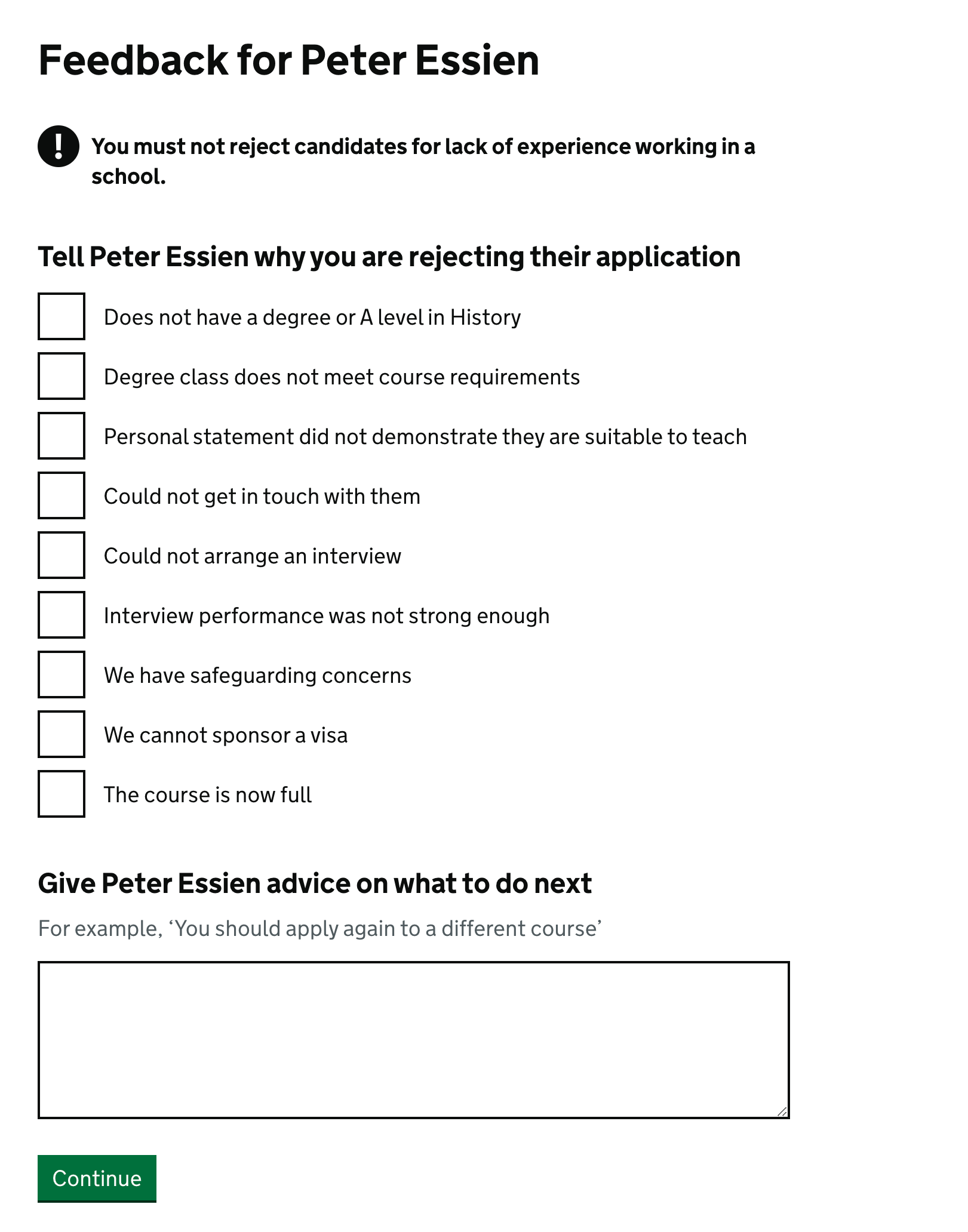
As part of some wider research and design work around the application criteria, we revisited the reasons that providers can select when rejecting a candidate, simplifying the interface and reducing the number of options.
The issue
In April 2022, the reasons for rejections were changed following several rounds of research and iteration. The final design that we shipped contained a set of checkboxes with category labels. When checked, most of the categories revealed a further set of checkboxes with more specific reasons. Checking these revealed a text input labelled ‘Details’.
Unfortunately, whilst this tested well in usability sessions, since we launched this design we’ve found that ‘Other’ has been the most selected option.
What we changed
We decided to try simplifying the design by removing the nested checkboxes, and instead only have a single list of checkboxes, which each still reveal a single ‘Details’ field.

We reduced the total number of checkboxes from 28 to 9, by grouping some of the checkboxes that we considered very similar.
The reasons that related to the statutory criteria for initial teacher training (having a degree and GCSE minimum grades, or equivalent) were moved onto separate pages.
The ‘Other’ option was removed – in part so that we could see within the usability research whether participants thought there were any additional options needed.
The content was also edited to have a consistent style and be more descriptive, for example ‘We cannot sponsor a visa’ instead of ‘Visa sponsorship’.
We added some warning text at the top to remind providers that they must not reject candidates for having a lack of experience working in a school.
Beneath the reasons for rejection, we added a text box where providers could give the candidate advice on what to do next.
Reasons for rejection: before
Qualifications:
- No maths GCSE at minimum grade 4 or C, or equivalent
- No English GCSE at minimum grade 4 or C, or equivalent
- No science GCSE at minimum grade 4 or C, or equivalent
- No bachelor’s degree or equivalent
- Degree does not meet course requirements
- Could not verify qualifications
- Other
Personal statement:
- Quality of writing
- Other
Teaching knowledge, ability and interview performance:
- Teaching knowledge, ability and interview performance
- Reasons
- Subject knowledge
- Safeguarding knowledge
- Teaching method knowledge
- Teaching role knowledge
- Teaching demonstration
- Other
Communication, interview attendance and scheduling:
- Did not reply to messages
- Did not attend interview
- Could not arrange interview
- Other
(Non-categorised):
- Safeguarding
- Visa sponsorship
- Course full
- Other
Reasons for rejection: after
- Does not have a degree or A level in [course subject]
- Degree class does not meet course requirements
- Personal statement did not demonstrate they are suitable to teach
- Could not get in touch with them
- Could not arrange an interview
- Interview performance was not strong enough
- We have safeguarding concerns
- We cannot sponsor a visa
- The course is now full
Research
We tested the changed designs in usability sessions with participants from 9 providers.
Most participants did not notice the change, or the lack of an ‘other’ option.
All participants said that the options covered all the rejection reasons they could think of, and could not suggest any missing ones.
They were mixed reactions to the warning content about not rejecting candidates due to a lack of experience working in a school. Some were already aware of this guidance, others suggested that this experience was still helpful for candidates, and one suggested it was almost essential.
Most providers liked the idea of the ‘advice on what to do next’ box, and suggested that it might:
- be helpful for candidates
- lead to fewer candidate requests for additional feedback from providers
- allow a more human, friendly approach
2 providers were not keen, and suggested that candidates should be looking elsewhere for this advice.
Participants suggested that there might be some cases where it would be difficult to give the candidate advice on what to do next, such as when applications were exceptionally poor, or the issue was that an interview could not be arranged.
Participants also suggested that there might be some overlap between content written in the advice box, and detail given in the boxes about why a candidate was not successful. However they thought they would be able to separate this out once they got used to the new design.
Future considerations
Before we make these changes to the live service, we need to consider:
- how we would update the rejection reasons in the candidate interface and emails
- whether or not we should go ahead with the separate advice box, and if it should be optional
- what the impact on the rejection codes in the API would be